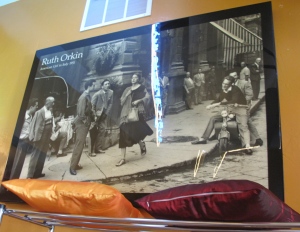 Last week I was on vacation in Wyoming. When I walked into a diner for lunch, I looked on the wall and exclaimed to my partner, “That’s street harassment!” Then I snapped the following picture of the poster, which clearly shows men ogling and harassing a woman who has a look of discomfort on her face.
Last week I was on vacation in Wyoming. When I walked into a diner for lunch, I looked on the wall and exclaimed to my partner, “That’s street harassment!” Then I snapped the following picture of the poster, which clearly shows men ogling and harassing a woman who has a look of discomfort on her face.
You can see a better version on ArtDaily.com:

Why did a random diner have street harassment on display? Today I looked up the photograph and found out it’s very famous and and the best known image by photographer Ruth Orkin. So I guess they were just displaying art…?
ArtDaily.com explains the photograph:
“In Florence, [Italy], Orkin had met Ninalee “Jinx” Allen Craig, an art student and fellow American who became the model for a series Orkin originally titled Don’t Be Afraid to Travel Alone, based on their joint experience as women traveling alone in Europe in the 1950s. Orkin photographed Craig shopping in the markets, crossing traffic, riding a carriage and flirting at a cafe.
By chance the two came upon the now famous pack of men. Orkin turned around and photographed Craig behind her. ‘I clutched my shawl to me because that sheaths the body,’ says Craig. ‘It was my protection, my shield. I was walking through a sea of men.’ Craig today admits, ‘I was enjoying every minute of it. They were Italian and I love Italians.’ Orkin asked Craig to walk through again, and with that she captured the famous image.”
First – I love that Orkin was traveling male companion-less during the 1950s and became famous for showing what it’s like to be a woman traveling alone, street harassment and all! Street harassment is still a part of many women’s experiences when they travel alone or with a female companion (and even sometimes when they travel with a male companion or their family) and it prevents women from having the same freedom to explore the world as men. And that’s a shame. I’m also intrigued that despite the obvious experience of street harassment, Orkin was encouraging women to not be afraid to travel alone.
Second – I am perturbed by the quotes from Craig. She was loving every moment of being harassed? Her expression in the photograph suggests otherwise, as does and the fact that she said she needed to use her shawl as protection, as a shield from the men.
And third – I wonder what people generally think when they see the photograph. If they think it’s quaint, funny, or interesting, and not the least problematic or offensive, then what is it accomplishing besides documentation? Not that she probably had an agenda for it besides documentation and making art. But I do have an agenda, and so for me, I wonder if this photograph helps or hinders or does neither for the movement to end street harassment.
So I leave you with three questions:
- What do you make of Craig’s seemingly contradictory statements about the experience?
- Do you think this photograph helps or hinders our movement to end street harassment?
- What do you think about a diner displaying this photograph of street harassment the way they would display a photograph of say, a landscape?
